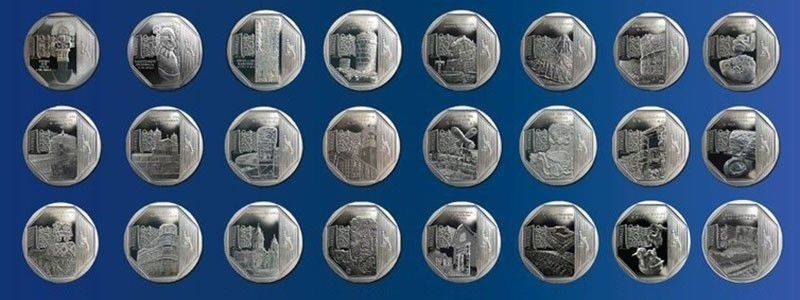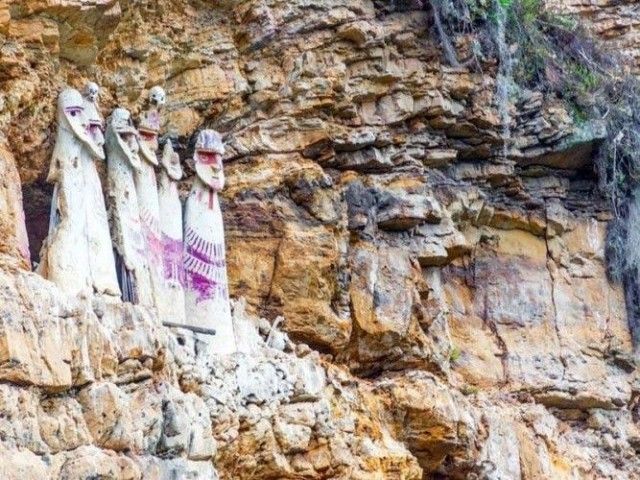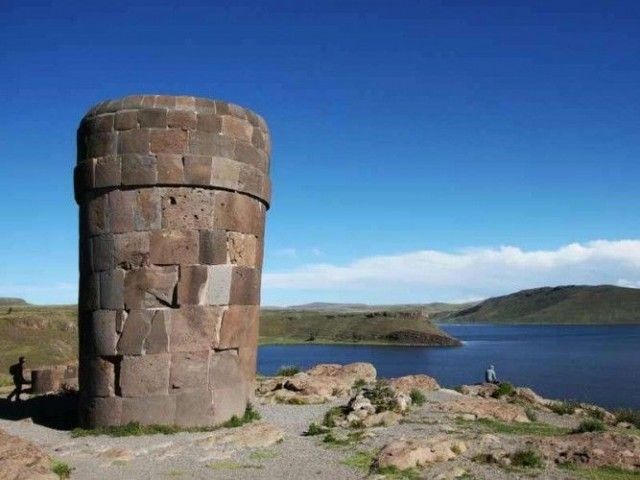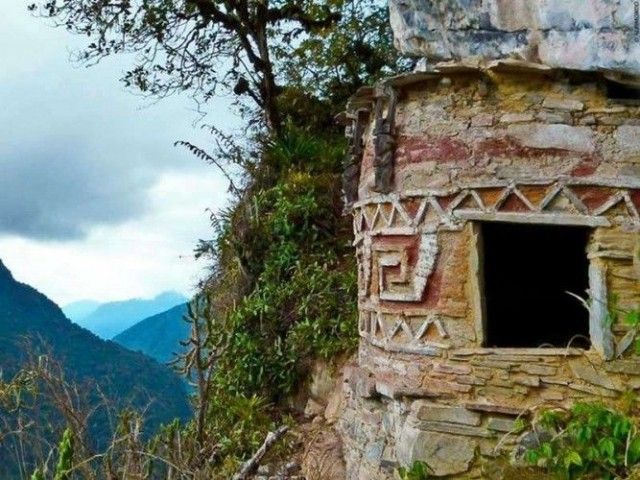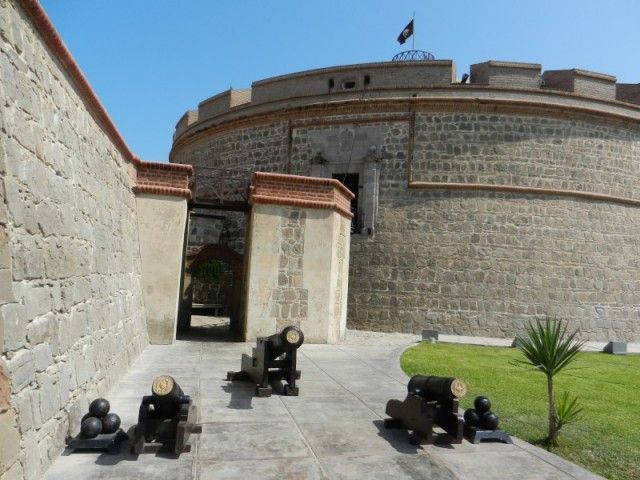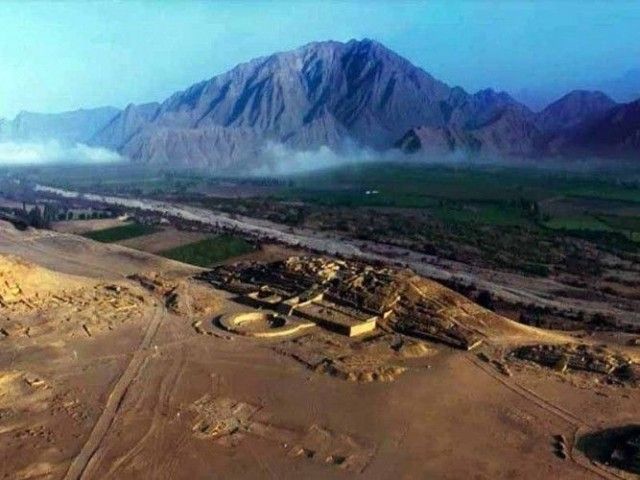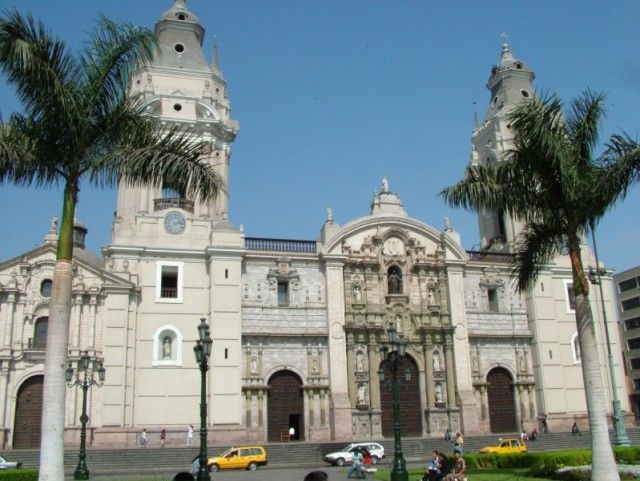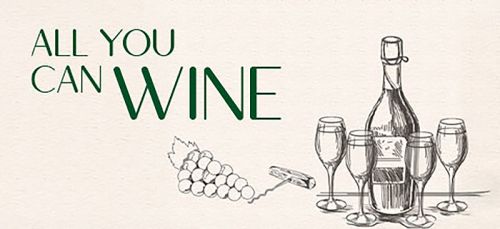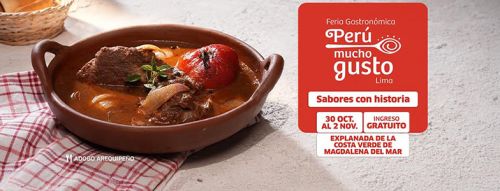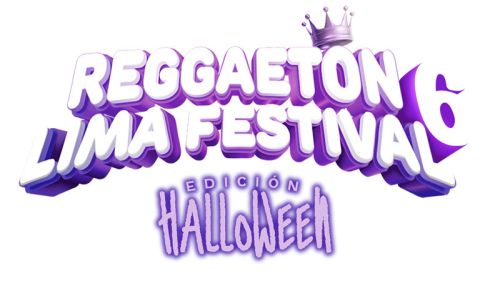The numismatic series "Riqueza y Orgullo del Perú" (Wealth and Pride of Peru) was issued by the Peruvian Central Reserve Bank (BCRP) to promote a numismatic culture and to spread the diverse and rich cultural heritage of Peru with one of the most commonly used coins in the country, the S/ 1 coin. Each of the 26 different coins in the series represents one of the 25 Peruvian regions and the autonomous province of Lima.
On the front of each Wealth and Pride coin an important cultural site, characteristic art or a tourist attraction of the region is depicted; the back shows the Peruvian Coat of Arms surrounded by the writing Banco Central de Reserva del Perú (Central Reserve Bank of Peru) and the year of issue.
All coins in the series have the denomination of One Nuevo Sol / One Sol (S/. 1 / S/ 1). They are legal tender. The coins circulate simultaneously with all other S/ 1 coins and can be used in any transaction in Peru. Of the first 16 coins, 10 million units and from the 17th coins on 12 million units have been minted.
Specifications:
- Value: One Nuevo Sol / One Sol (S/.1 / S/ 1)
- Date of issue: between 2010 and 2016
- Diameter: 25.5 mm
- Mass: 7.32g
- Material: Alpaca (copper alloy with nickel and zinc)
- Mintage: 10 million coins (1st to 16th coin), 12 million coins (17th to 26th coin)
- Front image: important cultural site, characteristic art or a tourist attraction representing one of the 25 Peruvian regions and the autonomous province of Lima and the logo of the National Mint on a background of vertical lines.
- Back image: Peruvian Coat of Arms
- Legal Tender: Yes
1st Wealth and Pride Coin - Tumi de Oro
The first coin of the Wealth and Pride numismatic series was issued on March 24, 2010. It represents the Lambayeque region in northern Peru known for its rich historical and cultural past.

The coin depicts the “Tumi de Oro”, a semi-circular, short-bladed, sacrificial knife most probably used during important religious ceremonies. The handle is decorated with "Ñaylamp", a mythological god-king of the Lambayeque culture.
2nd Wealth and Pride Coin - The Sarcophagi of Karajia
The 2nd coin of the Wealth and Pride numismatic series was issued on July 22, 2010. It represents the Amazonas region in northern Peru, mostly known for the Chachapoya culture and their walled city Kuelap.
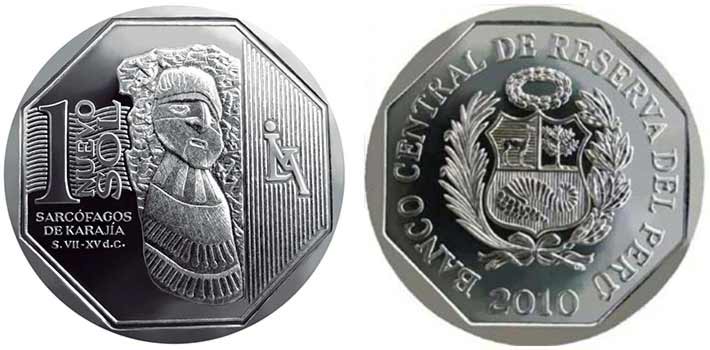
The coin, however, depicts the Sarcophagi of Karajia (Sarcófagos de Karajía), impressive funeral sculptures, or stone coffins that were built by the Chachapoya people. Located in the Utcubamba Valley, the funeral capsules stand high on the cliffside of the mountain facing the abyss. Measuring about 2.50 m (8.20 ft) in height, each sculpture was built using a mixture of clay and grasses that were spread across a wooden structure. Arranged in a fetal position and wrapped in layers of fabrics, deceased important personalities of the Chachapoya society were placed inside before the tomb was completely closed and decorated with an enormous head.
3rd Wealth and Pride Coin - Raimondi Stele
The 3nd coin of the Wealth and Pride numismatic series was issued on December 1, 2010. It represents the Ancash region in northern Peru, mostly known for the Chavin culture and their religious and political center “Chavin de Huantar”, today a UNESCO World Heritage Site.

The coin depicts the Raimondi Stele (Estela de Raimondi), a sacred monolith and probably the most significant representation of artistry of the Chavin people. The stele, which once had its place at “Chavin de Huantar”, is made of polished granite, nearly 2.00m (7ft) high and 0.74m (2.50ft) wide. Using a widely practiced Chavin technique named contour rivalry which creates multiple visual interpretations of an image, a filigree design was carved into the stone showing the Staff God (Dios de los Báculos) with an enormous head and the teeth of a feline accompanied by snakes when viewed from one side and many smiling, fanged faces with a huge reptile in the middle when viewed from the other. Today the Raimondi Stele can be admired at the National Museum of Archeology, Anthropology and History in Lima.
4th Wealth and Pride Coin: The Funerary Towers of Sillustani
The 4th coin of the Wealth and Pride numismatic series was issued on February 23, 2011. It represents the Puno region in southern Peru, mostly known for the Titicaca Lake.
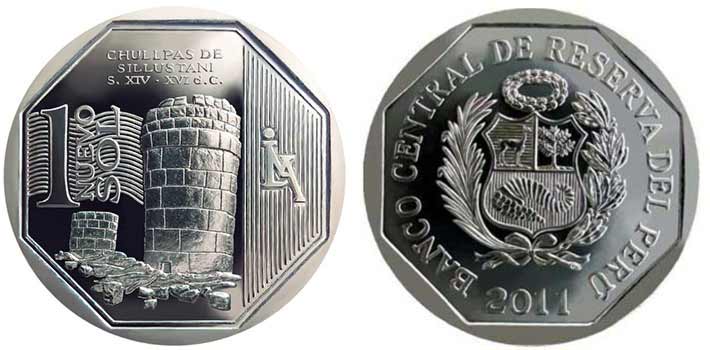
The coin, however, depicts the Chullpas de Sillustani, above ground tower-like tombs built by the Colla people, an Aymara speaking tribe that dominated the Titicaca region before the Incas. The funerary towers sit on a hill overlooking Lake Umayo about 35 km (20 miles) from the city of Puno. Inside the 12 m (40 ft) tombs, leaders and nobles of the community were buried while around the chullpas memories were guarded and ceremonial rituals performed.
5th Wealth and Pride Coin - Santa Catalina Monastery
The 5th coin of the Wealth and Pride numismatic series was issued on May 20, 2011. It represents the Arequipa region in southern Peru known for its capital city Arequipa, the White City and Peru’s second largest city, the Misti volcano and the Colca Canyon.
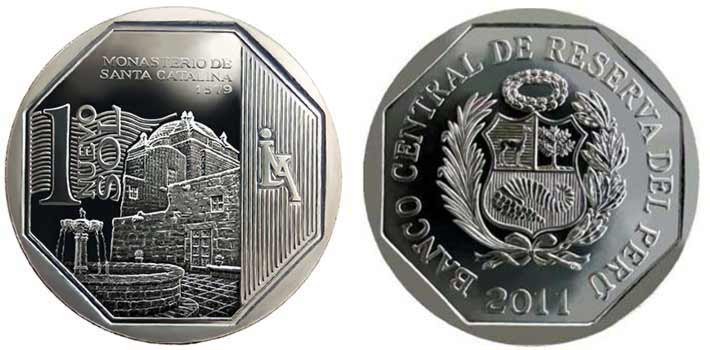
The coin however depicts the Santa Catalina Monastery (Monasterio de Santa Catalina), the most important and beautiful religious monument in Arequipa. The convent was founded in the late 16th century. Covering an area of 20,000 sqm (over 210,000 sq ft) the Santa Catalina Monastery is like a little town with an amazing architecture. Countless picturesque sites, the cloisters and many narrow alleys, named after Spanish cities, are filled with beautiful flowers and the walls are painted with vibrant colors. The monastery is open to the public and worth a visit.
6th Wealth and Pride Coin - Machu Picchu
The 6th coin of the Wealth and Pride numismatic series was issued on July 15, 2011. It represents the Cusco region in south-eastern Peru known for its capital city Cusco, the historical capital of the Inca Empire, the Sacred Valley and of course Machu Picchu.
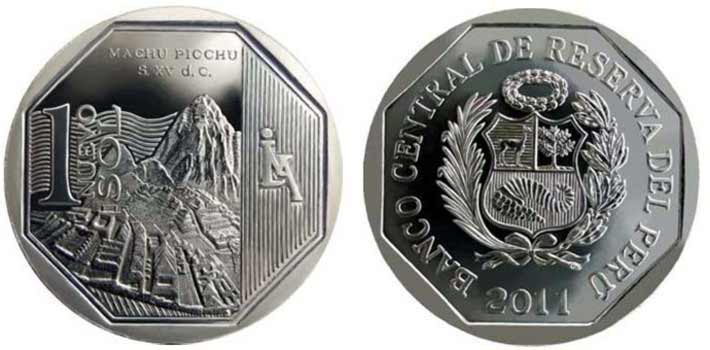
So. it’s no wonder that this coin depicts Machu Picchu, the most famous and most visited archaeological site in Peru built by the Incas in the 15th century. Named one of the New 7 World Wonders, the Inca citadel is located 80km (50 miles) beeline from the city of Cusco on a 2,430m (7,970 ft) high mountain ridge. Despite extensive excavations, research and restoration since its rediscovery in 1911, it’s still not clear why and how the Incas build the city in such an inaccessible mountainous terrain.
7th Wealth and Pride Coin - Gran Pajaten
The 7th coin of the Wealth and Pride numismatic series was issued on November 23, 2011. It represents the San Martin region in northern Peru known for its rich natural and cultural heritage.
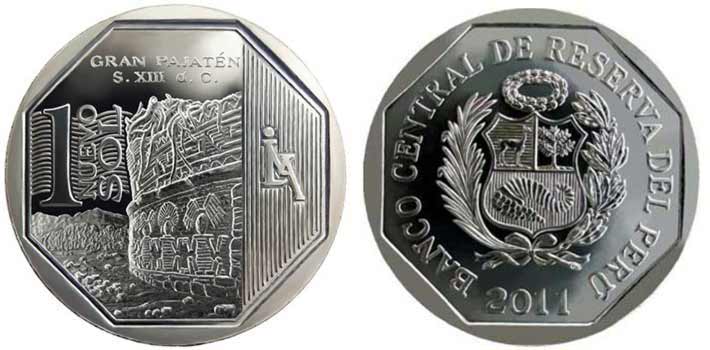
The coin depicts the ancient city of Gran Pajaten, which was built around 200BC by the Chachapoya culture in an inaccessible area on a hilltop amidst the Andean cloud forest overlooking the Rio Montecristo. Today part of the Rio Abiseo National Park - home to countless indigenous and endangered species of flora and fauna, as well as over 30 pre-Columbian archaeological sites - the Gran Patajen complex comprises at least 26 beautifully decorated circular stone structures built atop many terraces, narrow paths and steep staircases which connect the different levels of the site.
8th Wealth and Pride Coin - The Stone of Sayhuite
The 8th coin of the Wealth and Pride numismatic series was issued on March 21, 2012. It represents the Apurimac region in southern-central Peru known for its capital city Abancay and its stunning, unspoiled Andean landscapes.
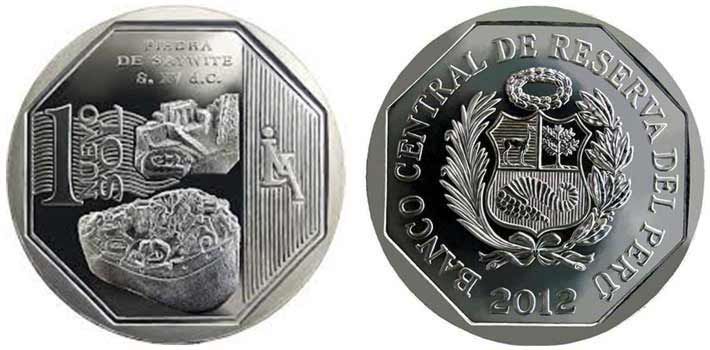
The coin depicts the Stone of Sayhuite (Piedra de Saywite), an enormous monolith sitting at the top of the Concacha hill inside the archaeological complex of Sayhuite, a presumably important center of religious worship focusing on water, which is located 47km (29 miles) from Abancay on the road to Cuzco. The Stone of Sayhuite is a granite block (2.5m / 8.2ft high, 4m / 13ft in diameter and 11m / 36ft in circumference) and most probably was sculptured during the Inca period. Over 200 figures are carved into the stone using the reliefs and natural depressions of the stone. The carvings include mountains, farming terraces, ponds, tunnels, irrigation channels, plains, buildings, people and different animals. We believe that the stone served as a scale model to develop, design, test, and teach water flow concepts.
9th Wealth and Pride Coin - Real Felipe Fortress
The 9th coin of the Wealth and Pride numismatic series was issued on July 3, 2012. It represents the Callao region, mostly known for its seaport, and the Jorge Chavez International Airport, which both serve as Lima’s gateway to the world.
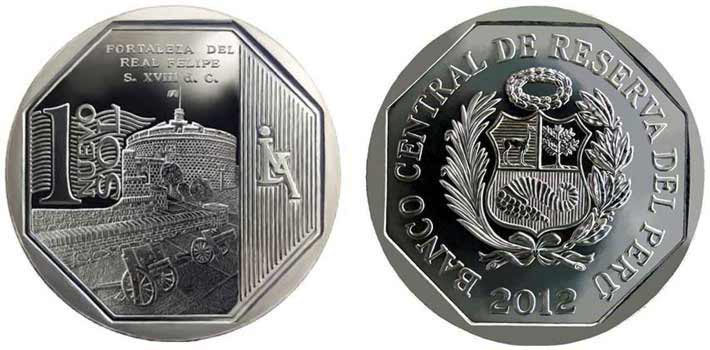
The coin depicts the Real Felipe Fortress, the largest and most impressive fortress the Spanish conquerors had ever built overseas to defend the riches and status of the Spanish crown in Peru. Today the Real Felipe Fortress houses an astonishing military history museum run by the Peruvian Army. Worth a visit!
10th Wealth and Pride Coin - Temple of the Sun in Vilcashuaman
The 10th coin of the Wealth and Pride numismatic series was issued on October 3, 2012. It represents the Ayacucho region in southern-central Peru. Nestled in the central Andean highlands it is known for its colors, folk art and handicrafts, its ancient Wari past and its churches.
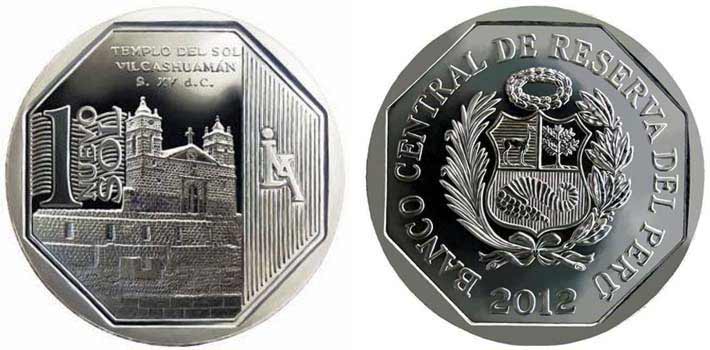
The coin depicts the Temple of the Sun (Templo del Sol) in Vilcashuaman which once was the most important religious and administrative center the Incas built outside their capital Cusco. But it’s as well one of the many examples of how the Spanish conquerors tried to eradicate old beliefs and impose their power and religion on the indigenous population. The Sun Temple was the most important sacral building in the ancient city where religious ceremonies and worship of the Inca gods took place. After the Spaniards conquered the area, they removed the upper part of the temple and built a Catholic church - the Church of San Juan de Bautista – on top of the remains by using the stones from the upper walls of the temple as building material and the lower part as foundation.
11th Wealth and Pride Coin - Kuntur Wasi
The 11th coin of the Wealth and Pride numismatic series was issued on December 5, 2012. It represents the Cajamarca region in northern Peru known for its ancient past, its living culture and its beautiful landscapes.

The coin depicts the largest of several beautifully carved stone monoliths found at Kuntur Wasi, an archaeological site in the Andean highlands near the small town of San Pablo. The religious complex was constructed, changed and added to by several cultures between 1200 and 200 BC. The complex comprises a hill-top temple, many partly stepped platforms, courtyards, funeral and other structures and several carved stone monoliths similar in style to the ones of the Chavín civilization. During excavations at the religious center many tombs containing stunning pieces of great archaeological value such as gold crowns, necklaces, stone beads, earrings and decorative breastplates were discovered which today are displayed at the on-site Kuntur Wasi Museum.
12th Wealth and Pride Coin - Inca Temple of Huaytara
The 12th coin of the Wealth and Pride numismatic series was issued on March 20, 2013. It represents the Huancavelica region in central Peru known for its rich ancient history, fertile lands and its lovely indigenous citizens of Quechua descent that unfortunately mostly live in poverty.
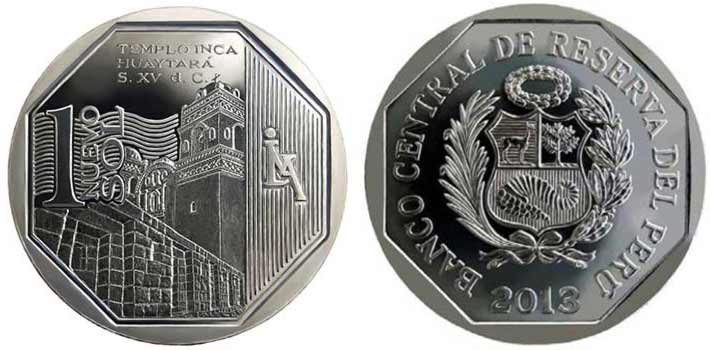
The coin depicts the Inca Temple of Huaytara (Templo Inca Huaytará), a declared Cultural Heritage of the Nation, which was built in the early 15th century by the Inca Pachacutec and presumably either was a site for religious ceremonies and worship of the Inca gods or a palace for the Inca royalty. The Inca Temple of Huaytara shares the same fate as the Temple of the Sun in Vilcashuaman. In the 16th century the Spaniards removed the upper part of the temple and using the bottom part as foundation built a Catholic church – the Church of San Juan de Bautista – on top of it.
13th Wealth and Pride Coin - Temple of Kotosh
The 13th coin of the Wealth and Pride numismatic series was issued on May 22, 2013. It represents the Huanuco region in central Peru named the soul of the Andes dressed in a jungle costume and known for its rich historical past dating back 10,000 years.
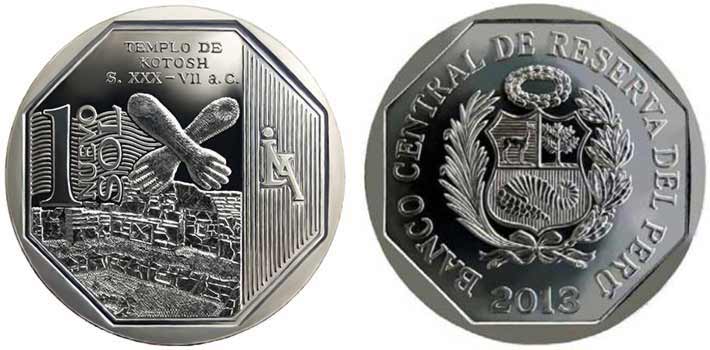
The coin depicts the Temple of the Crossed Hands (Templo de las Manos Cruzadas) built by the Kotosh civilization - one of the most ancient Andean cultures - about 4,000 years ago and enlarged crossed hands. The temple is part of an archaeological site located 5 km (3miles) from the city of Huanuco which comprises a series of buildings believed to be the earliest evidence of public and ceremonial architecture in the Andes. Two clay sculptures of the crossed hands can be found inside the temple in wall niches; one pair has the right hand over the left, the other the left hand over the right which according to archaeologists correspond to the idea of duality, common in later Andean civilizations.
14th Wealth and Pride Coin - Paracas Textile Art
The 14th coin of the Wealth and Pride numismatic series was issued on September 12, 2013. It represents the Ica region in southern Peru known for its characteristic dunes and vast desert, fertile fields, Pisco and its ancient cultures.
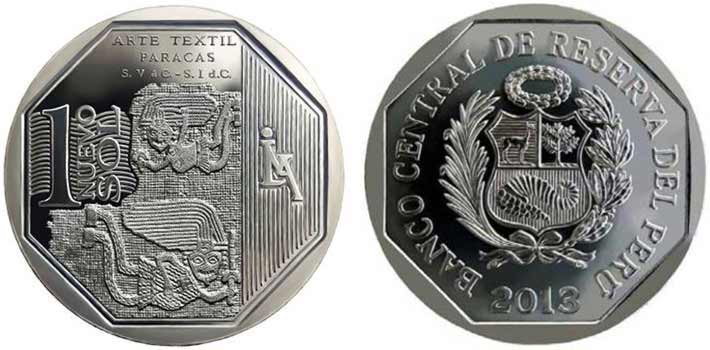
The coin depicts a fragment of a woven textile from the Paracas culture, an important pre-Inca civilization that inhabited the Paracas peninsula between around 600 BC and 200 AC. The Paracas are known for their unique and beautiful artwork and especially for their fabrics that impress with a highly advanced weaving technique, bright colors which they got dyeing cotton and wool (alpaca, llama and vicuña) with natural colors and beautiful designs including amazing geometrical ornaments, animals and anthropomorphic creatures.
15th Wealth and Pride Coin - Archaeological complex of Tunanmarca
The 15th coin of the Wealth and Pride numismatic series was issued on November 26, 2013. It represents the Junin region in central Peru known for its pristine landscapes with highlands, waterfalls, jungle and fertile valleys, its folk art and handicrafts as well as its deep religious traditions.
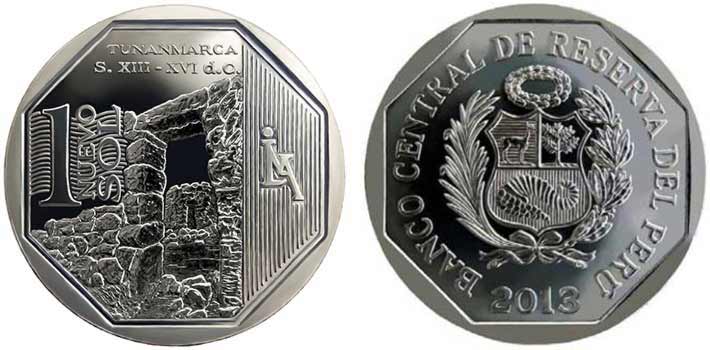
The coin depicts the archaeological site of Tunanmarca on 3,800m (12,500 feet) above sea level in the Andean highlands 20km (12 miles) west of the town of Jauja. The ancient city, which comprises 430 circular and rectangular stone buildings that are organized in groups around a central area and protected by walls, is believed to have been the capital of the Huanca or Wanka civilization. A central avenue divided the city and had a complex water management system with channels and underground pipes providing water to the entire population, about 20,000 people.
16th Wealth and Pride Coin - Sacred City of Caral
The 16th coin of the Wealth and Pride numismatic series was issued on April 2, 2014. It represents the Lima region in the central coast of Peru which consists of 10 provinces; the Lima province, which contains the Peruvian capital Lima, is autonomous and not part of it.
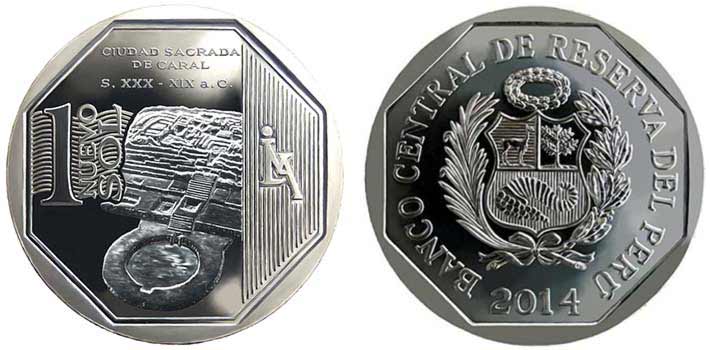
The coin depicts the Sacred City of Caral (Ciudad Sagrada de Caral) which was built by the Norte Chico civilization about 5000 years ago. Located 200km (125 miles) north of the capital Lima, the ancient city is the oldest urban center in the Americas and roughly as old as the pyramids in Egypt. Accommodating about 3000 people, Caral was most probably the capital of an advanced civilization featuring complex and monumental structures such as six enormous pyramids, temples, an amphitheater and residential buildings.
17th Wealth and Pride Coin Temple of the Moon
The 17th coin of the Wealth and Pride numismatic series was issued on August 6, 2014. It represents the La Libertad region in the northern coast of Peru known for its capital city Trujillo, the Marinera (Peru’s national dance), delicious food, exquisite colonial architecture and its rich ancient past.
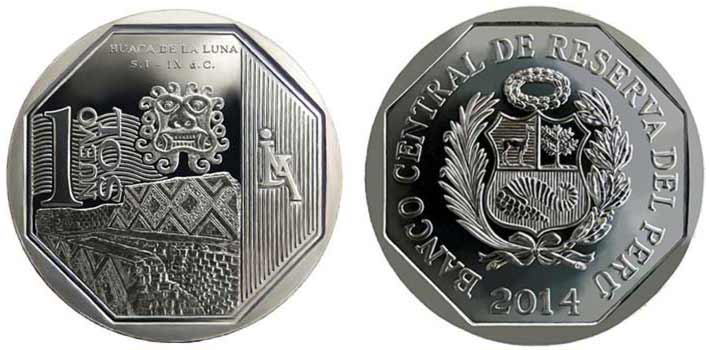
The coin depicts the Temple of the Moon (Huaca de la Luna) which is part of the archaeological complex named The Temples of the Sun and the Moon (Huacas del Sol y de la Luna) located just 4km (2.5 miles) outside Trujillo. The ancient site was built by the Moche culture and most probably was their most important urban and ceremonial center. While the impressive Temple of the Sun once was the largest adobe structure in the Americas (unfortunately today only about 30% of the original structure is left) and may have served for administrative, military, and residential functions, the smaller Temple of the Moon most probably has served primarily ceremonial and religious functions and impresses with its beautiful architecture, various plazas and large ceremonial spaces with stunning wall paintings.
18th Wealth and Pride Coin - Old Hotel Palace
The 18th coin of the Wealth and Pride numismatic series was issued on December 16, 2014. It represents the Loreto region in north-eastern Peru known for its capital Iquitos, the Amazon rainforest, its unspoiled, amazing nature and native communities.
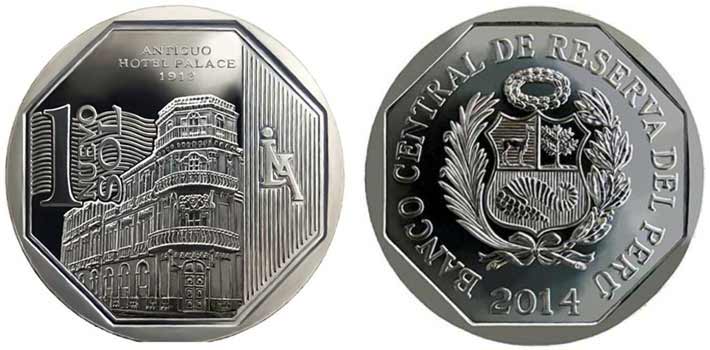
The coin however depicts the Old Hotel Palace (Antiguo Hotel Palace), a lavish art nouveau building with Catalan modernism from the school of Antoni Gaudí in the historic city center of Iquitos. Built between 1908 and 1912 by Peruvian civil engineer Samuel Young Mass and Spanish architect José Altamira y Motta on behalf of Otoniel Vela, the Old Hotel Palace was the first luxury hotel in Peru and housed many workers, merchants and foreigners during the Amazon rubber boom era. Since 1961 the hotel is the headquarters of the Eastern Military Region of Peru.
19th Wealth and Pride Coin - Cathedral of Lima
The 19th coin of the Wealth and Pride numismatic series was issued on January 22, 2015. It represents the autonomous province of Lima in the central coast of Peru which, contrary to the Lima region, contains the Peruvian capital.
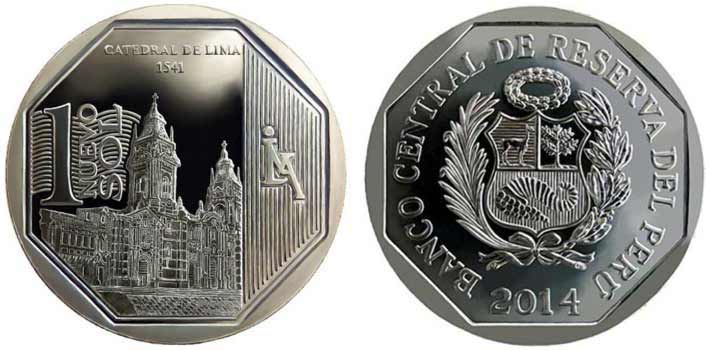
The coin depicts the Cathedral of Lima (Catedral de Lima) which groundbreaking ceremony took place on the foundation day of the colonial city of Lima on January 18, 1535. To suppress native religious customs, traditions and rites right from the start, the Spanish conquerors built the Cathedral of Lima, which during the Colonial era became the religious focus point of all Spanish colonies in South America, on top of an indigenous religious temple which was stripped down to its foundation. Because of damages caused by many earthquakes and expansions, the cathedral underwent countless repairs, alterations and restorations. Today’s Cathedral is based on the design and original plans of the building destroyed in 1746 by a massive earthquake. The impressive construction reflects different art epochs from Baroque to Neoclassicism and comprises a central nave with two side aisles and 13 chapels.
20th Wealth and Pride Coin - Petroglyphs of Pusharo
The 20th coin of the Wealth and Pride numismatic series was issued on March 25, 2015. It represents the Madre de Dios region in south-eastern Peru known for its never-ending forests, winding rivers, abundant wildlife and indigenous communities.
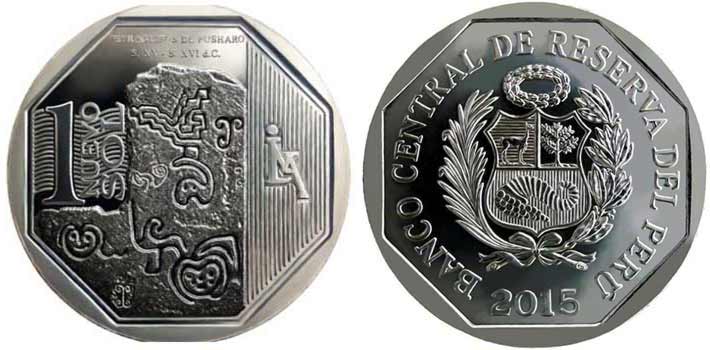
The coin depicts the Petroglyphs of Pusharo (Petroglifos de Pusharo), impressive, ancient rock carvings found in a remote area on the south shore of the Palatoa River in the southeast of the Manú National Park. The unique petroglyphs are hidden deep in the Amazonian rainforest and most probably are pan-Amazonian. They have a mystic-religious or shamanic significance to Amerindians who have inhabited the region for thousands of years and who are most likely their creators. The deeply incised rock carvings show faces, zigzags, spirals, suns, abstract symbols and other elements.
21st Wealth and Pride Coin - Moquegua architecture
The 21st coin of the Wealth and Pride numismatic series was issued on June 17, 2015. It represents the Moquegua region in southern Peru known for its scenic landscapes with fertile valleys, amazing beaches and Andean foothills, its picturesque towns, Pisco and distinctive colonial architecture.
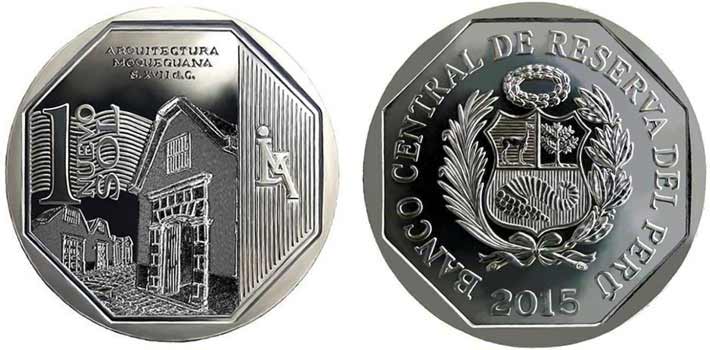
The coin depicts a characteristic cobblestone street with its houses in the city of Moquegua. They all feature the typical triangular or trapezoidal gable roofs, which have their origins in the colonial era dating back to the 17th century and are a distinctive feature of the Moquegua building style.
22nd Wealth and Pride Coin - Archaeological site of Huarautambo
The 22nd coin of the Wealth and Pride numismatic series was issued on November 4, 2015. It represents the Pasco region in central Peru known for breathtaking Andean landscapes, high jungle lush vegetation, lagoons, waterfalls, diverse flora and fauna, as well as its ancient past.
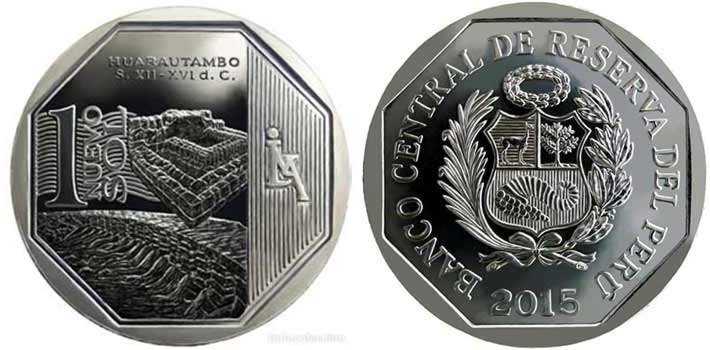
The coin depicts the archaeological complex of Huarautambo, also spelled Warawtampu (translated from Quechua “High Inn”) which was built by the Inca Pachacutec high in the Andes mountains on 3,600m (11,800 feet) halfway between the Inca capital Cusco and Cajamarca. Huarautambo was part of the Qhapaq-Ñan Inca road system and one of the most luxurious resting places along the way for travelers in the 15th century. Next to other buildings the site features the Inkawasi (the House of the Inca), the Wamiwasi (the Women's House where the Inca’s harem found their home) and the Phaqcha, an altar for water ceremonies including a pool built of polished stone.
23rd Wealth and Pride Coin - Vicus pottery
The 23rd coin of the Wealth and Pride numismatic series was issued on December 21, 2015. It represents the Piura region in the northern coast of Peru known for its beaches, eternal summer, its diverse flora and fauna as well as its delicious fruits and its rich ancient past.
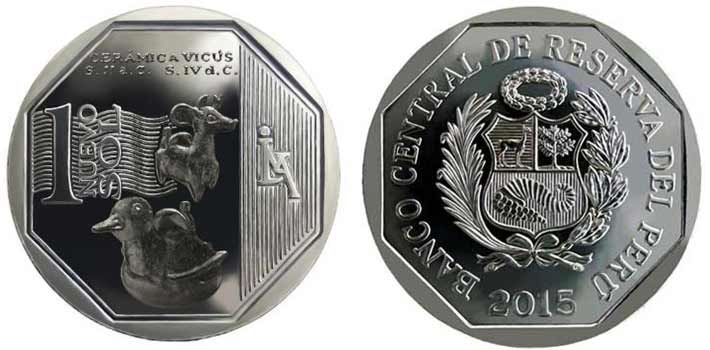
The coin depicts two clay figures - the duck and the deer- representing the Vicus culture which inhabited the area about 1500 and 2500 years ago and is known for their impressive artwork in copper, gold and ceramics.
24th Wealth and Pride Coin - Archaeological site Cabeza de Vaca
The 24th coin of the Wealth and Pride numismatic series was issued on April 6, 2016. It represents the Piura region in the northern coast of Peru known for its beautiful coastline with white sand beaches, mangroves swamps and tropical rainforest as well as its rich ancient past.
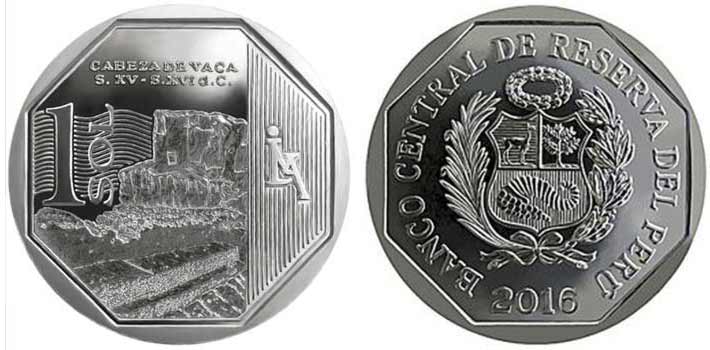
The coin depicts the archaeological site of Cabeza de Vaca, a ceremonial and administrative complex of the Incas. The Cabeza de Vaca complex most probably served as a provincial capital and hub connecting the coast with the northern Qhapaq-Ñan Inca road system that spanned throughout the Inca Empire. Most probably it was used to manage and control fishery and agriculture production in the area and the transit of goods up to the northern part of the empire including the city of Guayaquil in today’s Ecuador and back. As common in Inca architecture the city comprised beautiful buildings made of adobe and stone including the impressive Templo del Sol (the Temple of the Sun), the Acllahuasi (the House of the chosen women), other ceremonial buildings, plazas, houses, workshops and warehouses.
25th Wealth and Pride Coin - Shipibo-Konibo pottery
The 25th coin of the Wealth and Pride numismatic series was issued on July 14, 2016. It represents the Ucayali region in the Amazon rainforest of central Peru and is known for its rich Amazonian culture and the traditions and ethnic customs of its inhabitants.
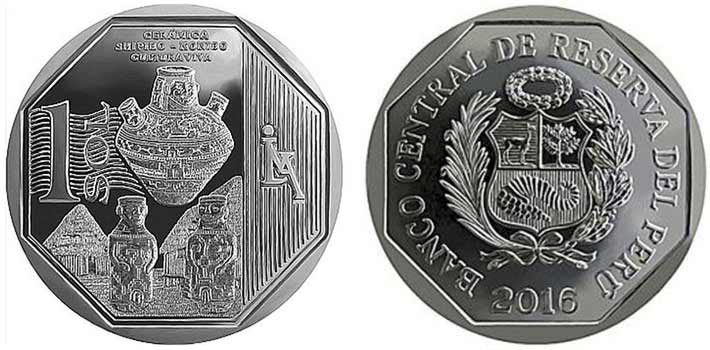
The coin depicts two characteristic thatched-roof huts from the Shipibo-Konibo tribe, indigenous people that live along the Ucayali River in the Amazon rainforest in Peru for centuries, and Shipibo-Konibo clay pottery known for its beautiful colored patterns and design. To this day the Shipibo-Konibo community with about 30,000 people value their ancestors, live in harmony with nature, keep their age-old traditions and customs alive and share their culture with us as well through their amazing pottery.
26th Wealth and Pride Coin - Parabolic Arch in Tacna
The 26th and final coin of the Wealth and Pride numismatic series was issued on September 29, 2016. It represents the Tacna region in southern Peru known for its unique scenery, with deserts and fertile valleys, between the coast and the mountains; its ancient past and heroic history during the War of the Pacific.
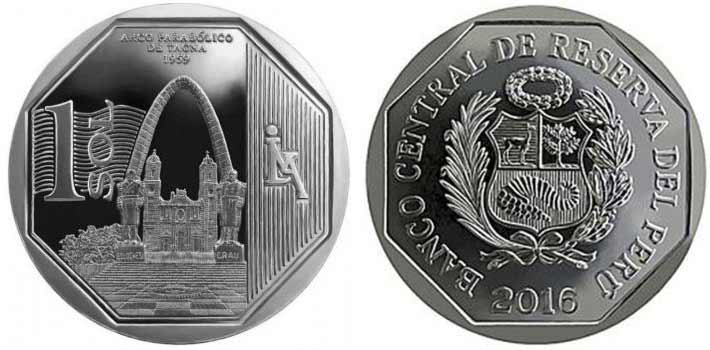
The coin depicts the iconic Parabolic Arch, a 18m (60 feet) monument built in the city center of Tacna at the Paseo Civico in honor of the heroes of the War of the Pacific, such as Admiral Miguel Grau and Colonel Francisco Bolognesi whose bronze statues flank the arch. The Tacna Parabolic Arch is made of beautiful quarried stone and was inaugurated in 1959 by then Peruvian President Manuel Prado. In the back, the Cathedral of Tacna is visible.


